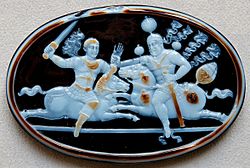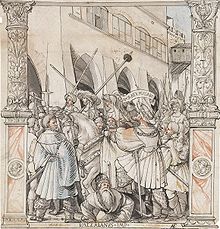Shapur I
| Shapur I 𐭱𐭧𐭯𐭥𐭧𐭥𐭩 | |
|---|---|
| "King of kings of Iran and Aniran"[1] (Middle Persian: šāhān šāh ērān ud anērān) | |
 | |
| Reign | 12 April 240 – May 270 |
| Predecessor | Ardashir I |
| Successor | Hormizd I |
| Born | c. 215 CE Possibly Firuzabad |
| Died | May 270 (aged 55) Bishapur |
| Burial | Unknown |
| Consort | Gurdzad Khoranzêm |
| Issue | Bahram I Narseh Hormizd I Shapur Mishanshah Casmak |
| House | House of Sasan |
| Father | Ardashir I |
| Mother | Lady Myrōd |
| Religion | Zoroastrianism |
Shapur I (Middle Persian: 𐭱𐭧𐭯𐭥𐭧𐭥𐭩, Šahpūhrī), also known as Shapur I the Great, was the second King of the Sassanid Empire. The dates of his reign are commonly given as 240/42 – 270/72 CE, but it is likely that he also reigned as co-regent (together with his father) prior to his father's death in 242 (more probably than 240).[2]
Early years
Shapur was the son of Ardashir I (r. 224–242 [died 242]), the founder of the Sassanid dynasty and whom Shapur succeeded. His mother was Lady Myrōd,[3] who—according to legend[4]—was an Arsacid princess. The Talmud cites a nickname for her, "Ifra Hurmiz", after her bewitching beauty.[5]
Shapur accompanied his father's campaigns against the Parthians, who — at the time — still controlled much of the Iranian plateau through a system of vassal states that the Persian kingdom had itself previously been a part of. Before an assembly of magnates, Ardashir "judged him the gentlest, wisest, bravest and ablest of all his children"[3] and nominated him as his successor. Shapur also appears as heir apparent in Ardashir's investiture inscriptions at Naqsh-e Rajab and Firuzabad.
The Iranian historian Muhammad ibn Jarir al-Tabari says the following thing about Shapur I before and after his ascension to throne:
The Iranians had well-tried Shapur already before his accession and while his father still lived on account of his intelligence, understanding and learning as well as his outstanding boldness, oratory, logic, affection for the subject people and kindheartedness.” Then when he came to the throne, he showed such generosity towards the nobility and commoners and took such care in running the state benevolently but efficiently that “he became renowned everywhere and gained superiority over all kings.”
The Cologne Mani-Codex indicates that, by 240, Ardashir and Shapur were already reigning together.[3] In a letter from Gordian III to his senate, dated to 242, the "Persian Kings" are referred to in the plural. Synarchy is also evident in the coins of this period that portray Ardashir facing his youthful son, and which are accompanied by a legend that indicates that Shapur was already referred to as king.
The date of Shapur's coronation remains debated. 240 is frequently noted,[3] but Ardashir lived very probably until 242.[6] 240 also marks the year of the seizure and subsequent destruction of Hatra, about 100 km southwest of Nineveh and Mosul in present-day Iraq. According to legend, al-Nadirah, the daughter of the king of Hatra, betrayed her city to the Sassanids, who then killed the king and had the city razed. (Legends also have Shapur either marrying al-Nadirah, or having her killed, or both.)[7]
War against the Roman Empire
First Roman war

Ardashir I had, towards the end of his reign, renewed the war against the Roman Empire. Shapur I conquered the Mesopotamian fortresses Nisibis and Carrhae and advanced into Syria. In 242, the Roman emperor Gordian III set out against the Sassanids with “a huge army and great quantity of gold,” (according to a Sassanid rock relief) and wintered in Antioch. There he fought against the Sassanids and won repeated battles, and drove out Shapur I from Antioch, Carrhae and Nisibis, and at last routed him at Resaena, forcing him to restore all occupied cities unharmed to their citizens. “We have penetrated as far as Nisibis, and shall even get to Ctesiphon,” he wrote to the Senate.
Gordian III later invaded eastern Mesopotamia but faced tough resistance from the Sassanids; following this blockade Gordian died in battle and Romans chose Philip the Arab as Emperor. Philip was not willing to repeat the mistakes of previous claimants, and was aware that he had to return to Rome in order to secure his position with the Senate. Philip concluded a peace with the Sassanids in 244; he had agreed that Armenia lay within Persia’s sphere of influence. He also had to pay an enormous indemnity to the Persians of 500,000 gold denarii.[8] Philip immediately issued coins proclaiming that he had made peace with the Persians (pax fundata cum Persis).[9] However, Philip later broke the treaty and seized lost territory.[10]
Shapur I commemorated his victory on several rock reliefs in Pars.

Second Roman war
Shapur I invaded Mesopotamia in 250 but suddenly there came a serious trouble in Khorasan and Shapur I had to march over there and settle its affair. Having settled the affair in Khorasan he resumed the invasion of Roman territories and later annihilated a Roman force of 60,000 at the Battle of Barbalissos and burned and ravaged the Roman province of Syria and all its dependencies.
Shapur I reconquered Armenia and appointed his son Hormizd I as the “Great King of Armenians”. With Armenia subjugated, Georgia submitted to the Sassanid Empire and fell under the supervision of a Sasanian official.[11] With Georgia and Armenia under control, the Sassanids' borders on the north were thus secured.
After his great victory against the Roman army at Barbalissos, Shapur divided his forces. Leading one army himself he penetrated deep into Syria all the way to the coast and plundered what he found, while his son Hormizd I took the other army and invaded Lesser Armenia and Cappadocia.
During Shapur's invasion of Syria he captured important Roman cities like Antioch. The Emperor Valerian (253–260) marched against him and by 257, Valerian had recovered Antioch and returned the province of Syria to Roman control. The speedy retreat of Shapur's troops caused Valerian to pursue the Persians to Edessa, but they were defeated by the Persians, and Valerian, along with the Roman army that was left, was captured by Shapur[9] and sent away into Pars.
Shapur advanced into Asia Minor and managed to capture Caesarea, deporting 400,000 of its citizens to the southern Sassanid provinces.[citation needed]
However, he was later defeated by Balista and Septimius Odenathus, who captured the royal harem. Shapur plundered the eastern borders of Syria and returned to Ctesiphon, probably in late 260.[12] In 264 Septimius Odenathus reached Ctesiphon, but was defeated by Shapur I.[13][14][15]

One of the great achievements of Shapur's reign was the defeat of the Roman Emperor Valerian. This is presented in a mural at Naqsh-e Rustam, where Shapur is represented on horseback wearing royal armour and crown. Before him kneels Valerian, in Roman dress, asking for grace. The same scene is repeated in other rock-face inscriptions.[16] Shapur is said to have publicly shamed Valerian by using the Roman Emperor as a footstool when mounting his horse.[17] Other sources contradict and note that in other stone carvings, Valerian is respected and never on his knees. This is supported by reports that Valerian and some of his army lived in relatively good conditions in the city of Bishapur and that Shapur enrolled the assistance of Roman engineers in his engineering and development plans.
The colossal statue of Shapur I, which stands in the Shapur cave, is one of the most impressive sculptures of the Sasanian Empire.
Builder of cities
Shapur I left other reliefs and rock inscriptions. A relief at Naqsh-e Rajab near Estakhr, is accompanied by a Greek translation. Here Shapur I calls himself "the Mazdayasnian (worshipper of Ahuramazda), the divine Sapores, King of Kings of the Iranians, and non-Iranians, of divine descent, son of the Mazdayasnian, the divine Artaxerxes, King of Kings of the Aryans, grandson of the divine king Papak." Another long inscription at Istakhr mentions the King's exploits in archery in the presence of his nobles. From his titles we learn that Shapur I claimed sovereignty over the whole earth, although in reality his domain extended little farther than that of Ardashir I. Shapur I built the great town Gundishapur near the old Achaemenid capital Susa, and increased the fertility of the district with a dam and irrigation system — built by Roman prisoners — that redirected part of the Karun River. The barrier is still called Band-e Kaisar, "the mole of the Caesar." He is also responsible for building the city of Bishapur, with the labours of Roman soldiers captured after the defeat of Valerian in 260.
Interactions with minorities
Shapur is mentioned many times in the Talmud, as King Shabur. He had good relations with the Jewish community and was a friend of Shmuel, one of the most famous of the Babylonian Amoraim.
Under Shapur's reign, the prophet Mani, the founder of Manichaeism, began his preaching in Western Iran, and the King himself seems to have favoured his ideas. The Shapurgan, Mani's only treatise in the Middle Persian language, is dedicated to Shapur.
Roman prisoners of war
Shapur's campaigns deprived the Roman Empire of resources while restoring and substantially enriching his own treasury, by deporting many Romans from conquered cities to Sassanid provinces like Khuzestan, Asuristan, and Pars. This influx of deported artisans and skilled workers revitalized Persia’s domestic commerce.[18]
Death
In Bishapur, Shapur died of an illness. His death came in May 270 and he was succeeded by his son, Hormizd I. Two of his other sons, Bahram I and Narseh, would also become kings of the Sasanian Empire, while another son, Shapur Mishanshah, who died before Shapur, left children who would hold exalted positions within the empire.[19]
Portrayals In Popular Fiction
Shapur appears in Harry Sidebottom's historical fiction novel series as one of the enemies of the series protagonist Marcus Clodius Ballista, career soldier in a third-century Roman army.
References
- ^ MacKenzie, David Niel (1998). "Ērān, Ērānšahr". Encyclopedia Iranica. Vol. 8. Costa Mesa: Mazda.
- ^ ARDAŠĪR I, Joseph Wiesehöfer, Encyclopaedia Iranica, (August 11, 2011).[1]
- ^ a b c d Shahbazi, Shapur (2003). "Shapur I". Encyclopedia Iranica. Costa Mesa: Mazda.
- ^ Herzfeld, E. E. (1988). Iran in the Ancient East. New York: Hacker Art Books. ISBN 0-87817-308-0. p. 287.
- ^ Talmud Bavli, Tractate Baba Basra 8a. See there note 56 in Artscroll edition(2004)
- ^ J. Wiesehöfer, Ardasir, in: Encyclopedia Iranica.
- ^ "Hatra". Encyclopædia Britannica. Encyclopædia Britannica Inc. 2008. Retrieved 8 December 2007.
- ^ SHAPUR I, Shapur Shahbazi, Encyclopaedia Iranica, (July 20, 2002).[2]
- ^ a b Cambridge History of Iran, Volume III,edited by Ehsan Yarshater (professor of Iranian studies, Columbia University, New York)
- ^ SHAPUR I, Shapur Shahbazi, Encyclopaedia Iranica.[3]
- ^ SHAPUR I, Shapur Shahbazi, Encyclopaedia Iranica.[4]
- ^ SHAPUR I, Shapur Shahbazi, Encyclopaedia Iranica.[5]
- ^ Who's Who in the Roman World By John Hazel
- ^ Babylonia Judaica in the Talmudic Period By A'haron Oppenheimer, Benjamin H. Isaac, Michael Lecker
- ^ The New Encyclopaedia Britannica
- ^ Grishman,R.(1995):Iran From the Beginning Until Islam
- ^ Prof. A. Tafazzoll, (1990): History of Ancient Iran, pg. 183
- ^ SHAPUR I, Shapur Shahbazi, Encyclopaedia Iranica.[6]
- ^ SHAPUR I, Shapur Shahbazi, Encyclopaedia Iranica.[7]
- This article incorporates text from a publication now in the public domain: Chisholm, Hugh, ed. (1911). Encyclopædia Britannica (11th ed.). Cambridge University Press.
{{cite encyclopedia}}: Missing or empty|title=(help)
